Ever looked at an old barn and thought, “Wow, this place could be something special!”? Trust me, you’re not alone. Turning a rustic barn into a welcoming, eye-catching spot is actually easier than you might think—it just takes the right inspiration.
With the perfect mix of greenery, pathways, and a few creative touches, you can turn any barnyard into your new favorite hangout.
I’ve gathered a bunch of unique barn landscaping ideas that will help you make the most of your space, whether you’re dreaming of a peaceful retreat or the ultimate gathering spot.
Ready to give your barn a whole new vibe? Let’s dive in!
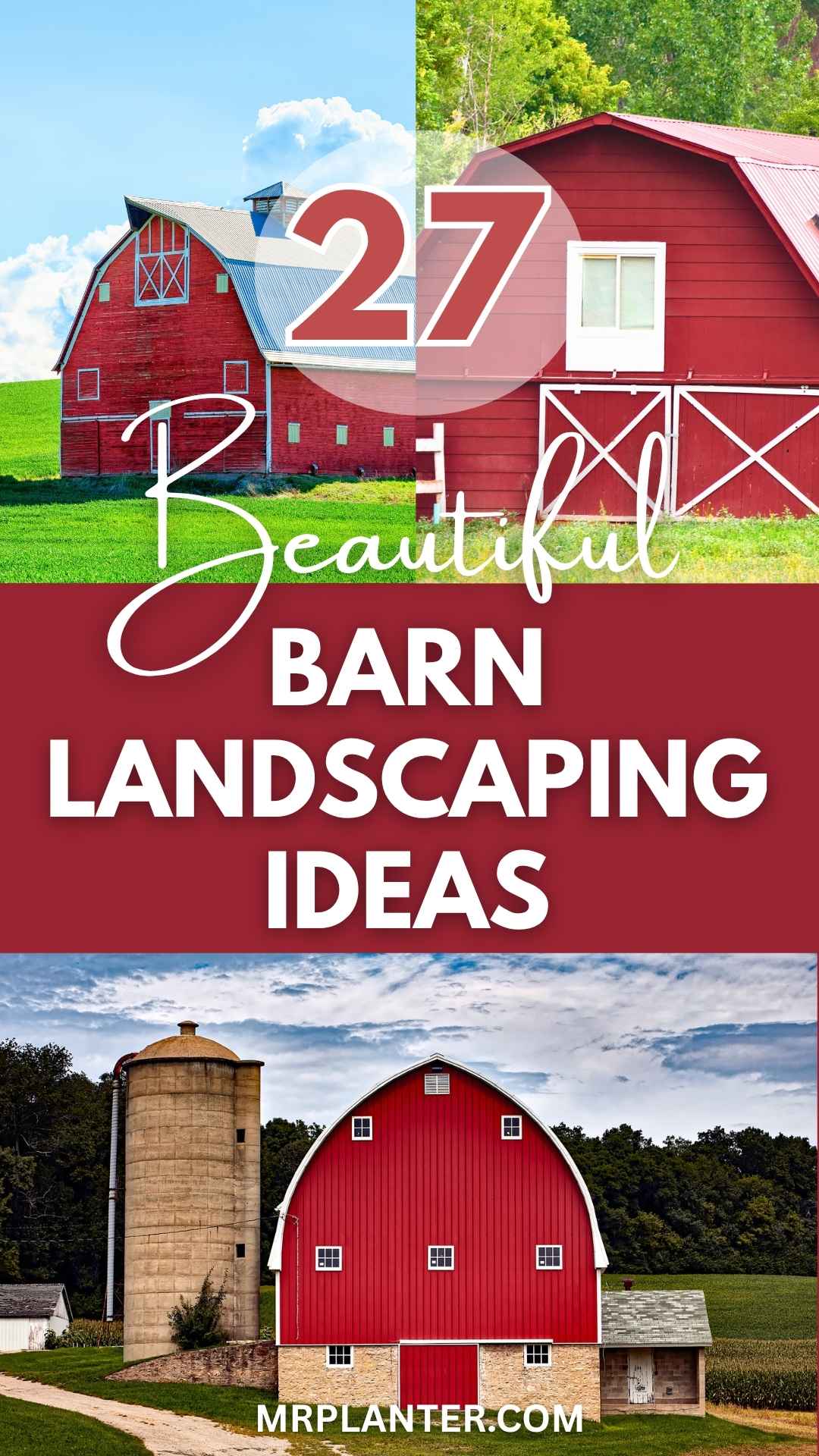
1. Create a gravel circle for gatherings

A gravel circle near your barn makes a simple, inviting spot. Use it for sitting, chatting, or even a fire pit.
It can turn an empty patch into a cozy hangout for family or friends. To keep things tidy, lay landscape fabric under the gravel.
That way, weeds stay away and the gravel won’t shift around as much. Pick gravel that goes with your barn’s colors for a natural vibe.
Put benches or chairs around the circle. Toss in some big stones or a fire bowl in the middle to finish the look.
This setup pretty much begs people to relax and enjoy your outdoor space.
Expert Tip from MrPlanter: “Mix small and medium gravel for texture and less shifting. Keep your circle about 10 to 15 feet wide so folks can move and sit comfortably.”
2. Plant native wildflowers around the barn
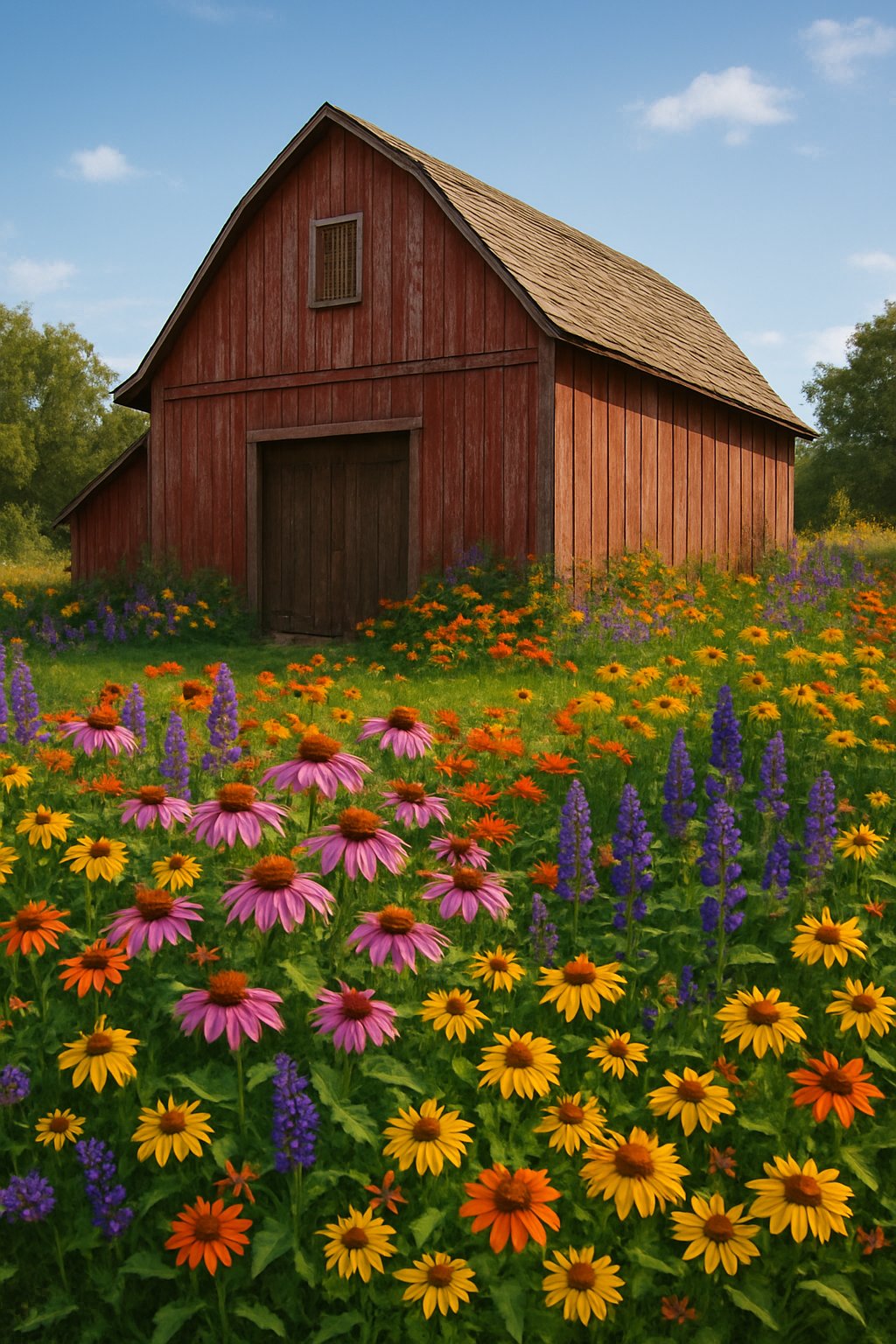
When you plant native wildflowers around your barn, you brighten the area naturally. These flowers already know your local soil and weather, so they grow with less fuss.
Wildflowers draw in bees, butterflies, and other pollinators. This keeps your landscape lively and helps local wildlife.
You’ll probably spot more buzzing and fluttering around your barn. Native wildflowers also need less water and fewer chemicals than non-natives.
That means less work and money for you, plus it’s better for the environment. Pick a mix of wildflowers that bloom at different times.
That way, your barn area stays colorful through the seasons. Scatter wildflower seeds on bare soil or add them to garden beds.
Just make sure the spot gets plenty of sun for the best results.
Expert Tip from MrPlanter: “Start with wildflowers native to your area for the best growth. Water them gently but regularly until they’re established.”
3. Install brick or stone patios

Put in a brick or stone patio and you’ll add both charm and function to your barn’s outdoor space. Patios give you a solid spot for seating, gatherings, or even work.
Pick from brick, natural stone, or concrete pavers—just depends on the look you like. When you plan your patio, start by marking the shape you want.
Lay pavers tight together to keep the surface smooth. Smaller stones or pavers work great for curves or round patios.
Brick and stone patios last a long time and don’t need much upkeep. They blend in with rustic barns and natural landscaping.
Try adding potted plants or simple flower beds around your patio to soften the hardscape.
Expert Tip from MrPlanter: “Use chalk lines to outline your patio before you start. It helps keep everything neat and straight.”
4. Add potted plants near entrances
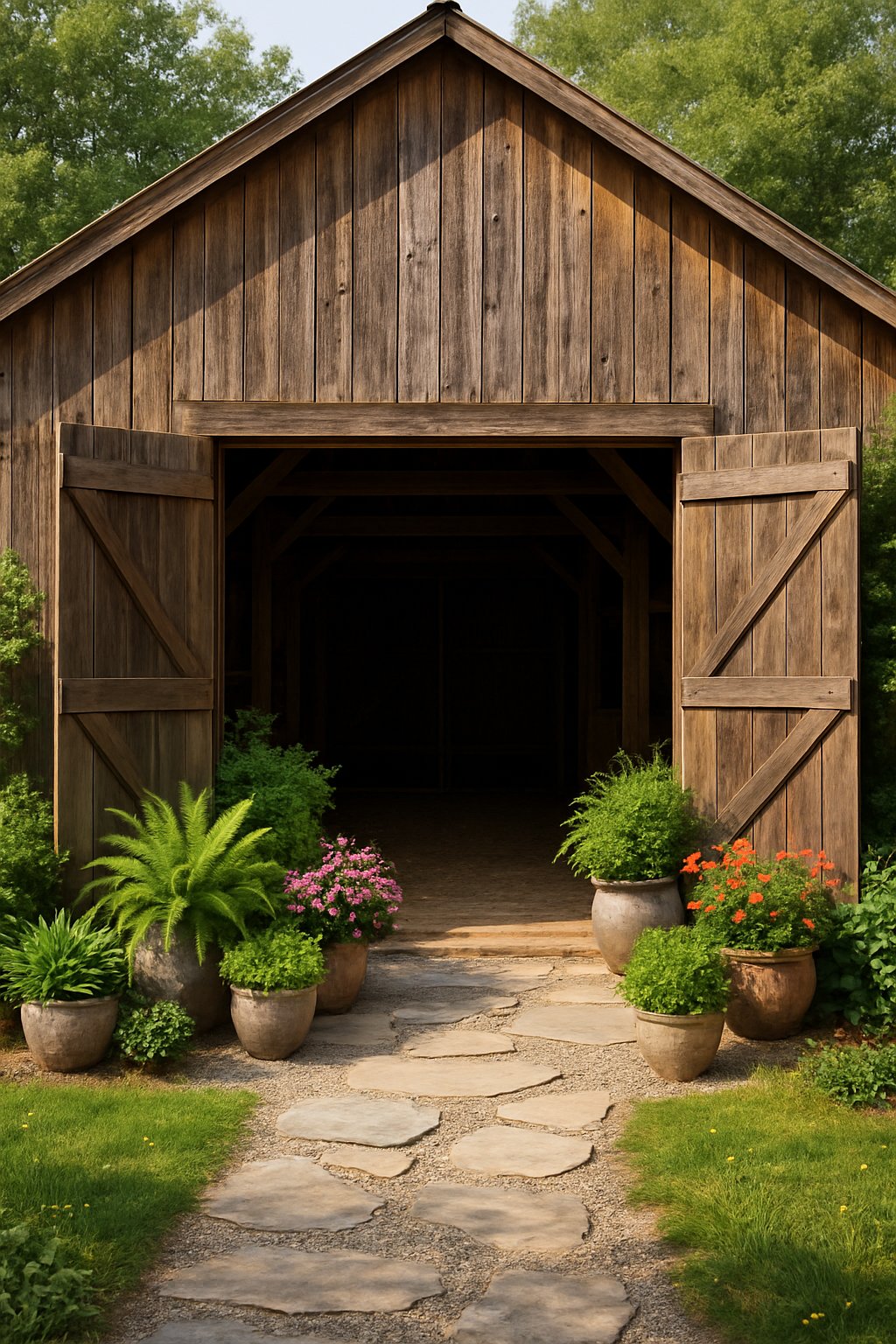
Set some potted plants by your barn’s entrance and you’ll instantly make it feel more welcoming. Pick containers that fit your barn’s style—rustic pots, metal urns, whatever suits you.
You can swap out plants by season for a fresh look all year. Use colorful flowers like pansies or violas to brighten things up.
Evergreen plants work too, giving you greenery even in winter. Group pots of different heights for a little extra interest.
Make sure your pots are easy to move. That way, you can clean up or change plants in a snap.
Just a few well-placed containers will make your barn’s entrance pop without much effort.
Expert Tip from MrPlanter: “Choose plants that thrive in your local climate for less hassle. Always use pots with drainage so roots stay healthy.”
5. Use reclaimed wood accents
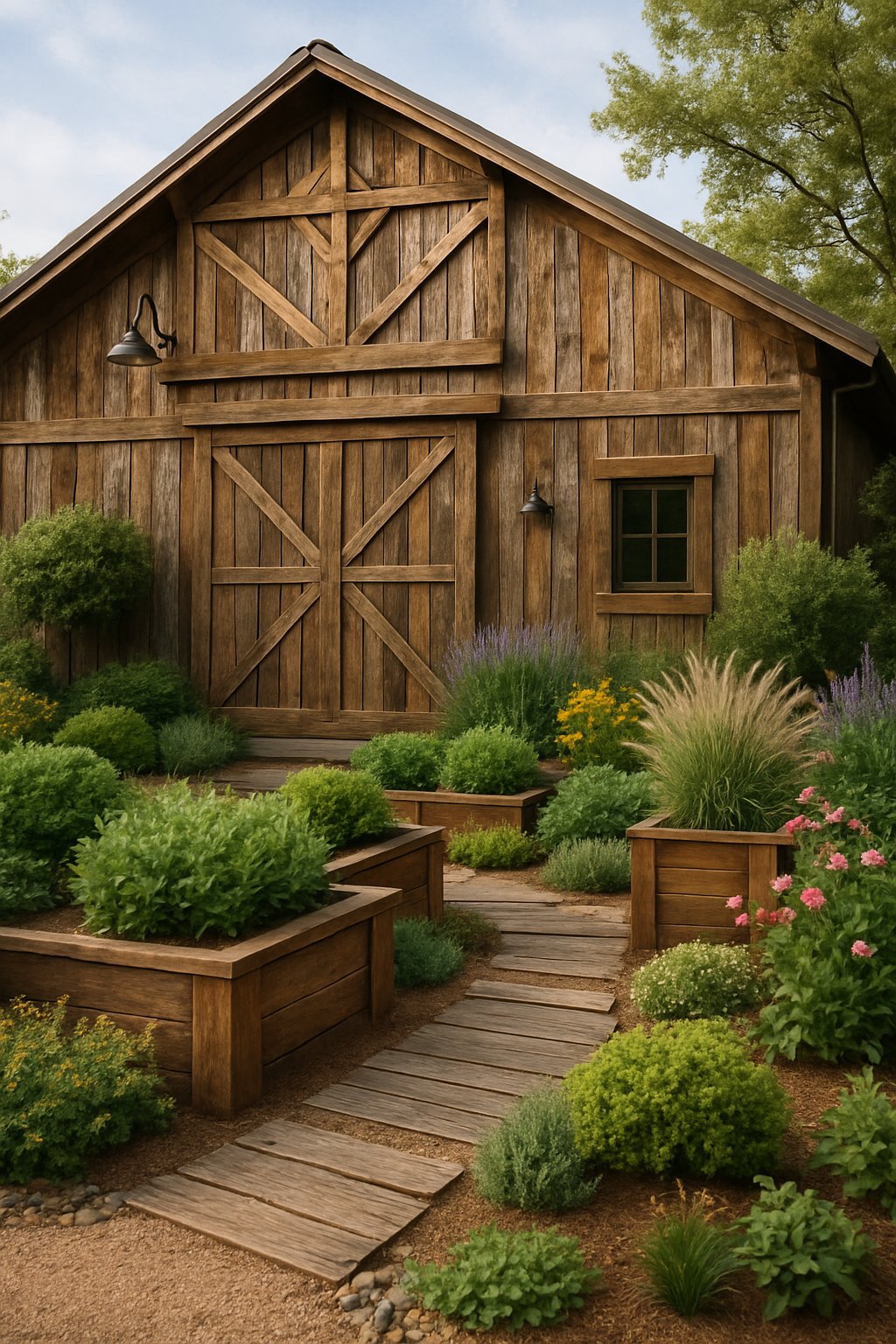
Add reclaimed wood accents to your barn landscaping for a warm, natural feel. Use weathered wood for fences, gates, or planter boxes.
These touches give your barn a rustic look that just fits. Reclaimed wood lasts a long time and helps the environment since you’re reusing old wood.
Try making small signs or decorative features with it around your barn. Mixing up different textures and colors of reclaimed wood adds depth to your design.
It also pairs well with plants and other natural elements.
Expert Tip from MrPlanter: “Go for weather-treated reclaimed wood so it holds up outdoors. Use it where it’ll catch the eye but still blend in with nature.”
6. Build defined walkways with mulch or gravel

If you use mulch or gravel for walkways around your barn, you’ll keep things tidy and mud-free. Both options are easy to put in and won’t break the bank.
Just clear the path, roll out landscape fabric, and spread your mulch or gravel. Mulch gives a soft, natural look that goes well with plants and trees.
It keeps moisture in and weeds out. Gravel gives you better drainage and a firmer path, which comes in handy for wet spots.
You can make straight paths or add some curves for visual interest. Edge your walkways with wood or stone to keep everything in place.
That way, your barn area stays neat and easy to get around all year.
Expert Tip from MrPlanter: “Mulch is great for a casual, natural vibe, but pick gravel if you need durability. Always use landscape fabric underneath to keep weeds down.”
7. Plant a border of fragrant herbs

Planting a border of fragrant herbs around your barn brings beauty and function. Herbs like lavender, mint, thyme, and rosemary give off strong scents that make your outdoor space more enjoyable.
These herbs attract bees and butterflies, which help other plants nearby. Most herbs stay green all season and don’t need much care once they get going.
Space your plants about 12 to 18 inches apart for a thick, lush border. Trim them often to keep them healthy and encourage new growth.
Try mixing different herbs for layers of scent and texture. That makes your barn area look lively and inviting.
Keep the soil well-drained to avoid root problems. Most herbs like a sunny spot, so plant them where they’ll get plenty of light.
Herb borders are also handy if you cook or make natural remedies. You can grab fresh herbs whenever you need them.
Expert Tip from MrPlanter: “Deadhead your herbs often to keep them blooming and smelling great. Plant in blocks for stronger scents and easier harvesting.”
8. Set up a rustic wooden fence

When you add a rustic wooden fence, your barn area gets a warm, natural border. Use weathered or reclaimed wood so the fence blends in with your outdoor setting.
Simple styles like picket or split rail fences work well here. A wooden fence defines your space and supports climbing plants such as clematis or ivy.
It creates a charming border but doesn’t steal the show from your garden. Try woven branches if you want something unique and a bit more wild.
Pick wood that holds up outside, and treat it to last longer. Rustic fences don’t have to be perfect—little flaws make them even better.
Keep the fence low if you want things to feel open and friendly.
Expert Tip from MrPlanter: “Reclaimed barn wood is cheap, eco-friendly, and full of character. Treat your wood with a weatherproof sealant so it lasts all year.”
9. Mix tall grasses with perennial flowers

Tall grasses add texture and movement to your barn landscape. Plant them with perennial flowers for a natural, balanced look.
Pick flowers like black-eyed Susans or coneflowers. These bloom in late summer or fall, so they match the grasses’ seasonal interest.
This mix keeps your garden colorful for longer. Grasses sway in the breeze, and flowers give you bright pops of color.
Perennials don’t need much care once established, making them a low-maintenance pick. Put grasses in clusters and sprinkle flowers between them for a relaxed feel.
This combo softens the hard lines of barn walls or fences. It helps your barn flow into the rest of your yard.
Expert Tip from MrPlanter: “Plant taller grasses in back and shorter flowers up front for depth. Group plants with similar water needs to make care easier.”
10. Incorporate a small water feature
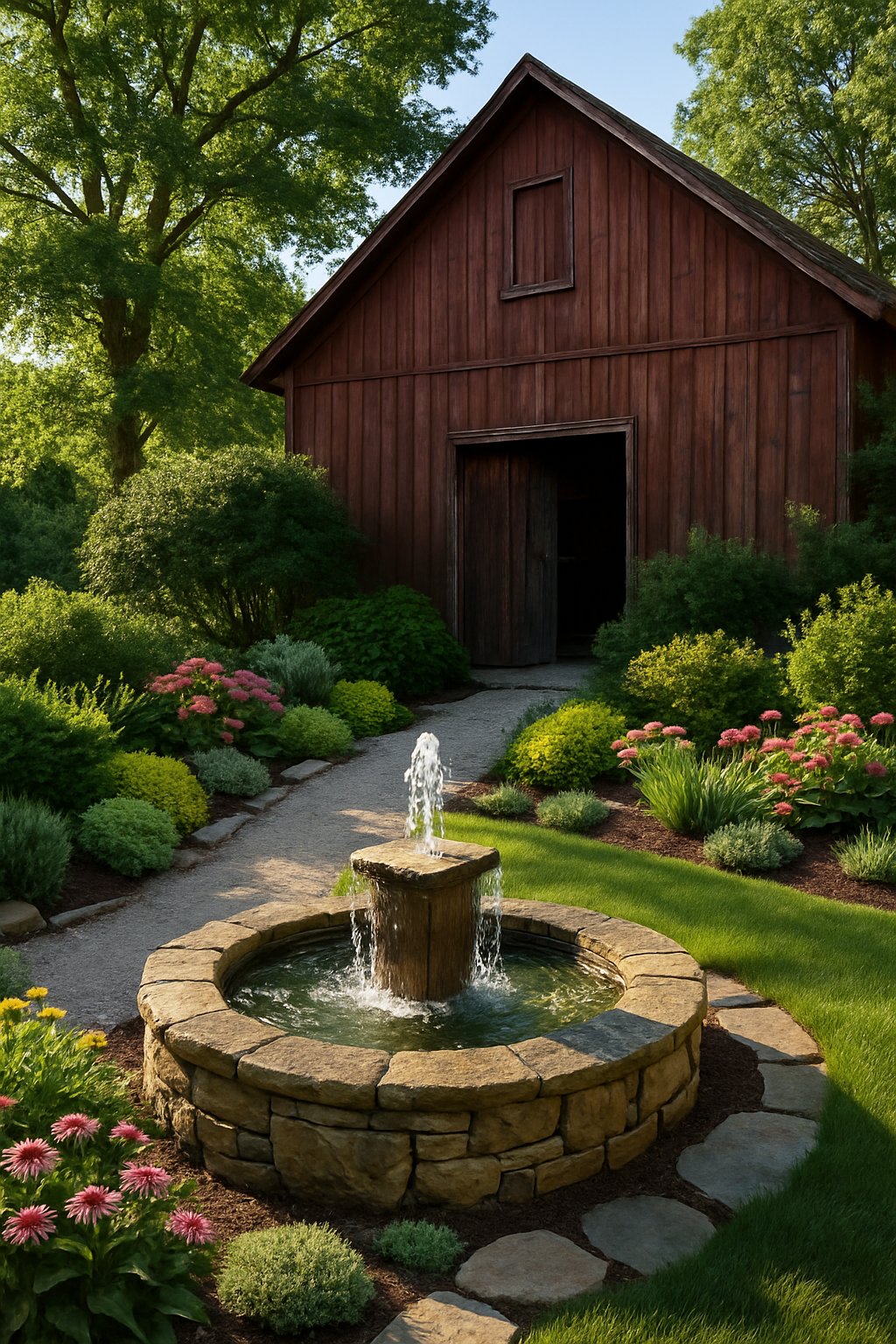
Try adding a small water feature near your barn. It brings a sense of calm and a touch of beauty to the space.
You could go for a pond, a fountain, or maybe just a birdbath with a fountain attachment. These features create peaceful sounds and attract birds and other wildlife—honestly, who doesn’t love that?
A simple water element doesn’t need much room. Even a glazed ceramic dish with water can attract insects and birds.
Hang a rain chain from your barn or a nearby structure if you want some gentle water sounds and a bit of style. It’s a small detail, but it really works.
Water features can become the focal point in your landscaping. Try placing lighting nearby to highlight the water at night and make your barn area more inviting after dark.
Don’t forget about maintenance—small pumps and easy-to-clean designs make things a lot simpler.
Expert Tip from MrPlanter: “Choose a water feature that fits your barn’s size and style. Regular cleaning keeps it fresh and inviting all year long.”
11. Line paths with solar garden lights

Try lining your barn’s paths with solar garden lights. This makes it much safer to walk at night and adds a nice glow.
These lights charge during the day and turn on by themselves after dark. You won’t need extra wiring, so installation is pretty easy.
Solar lights come in all sorts of shapes and sizes. You might like classic dome lights that shine downward, or maybe you’ll pick decorative bulbs that cast light higher up.
Both options help guide your steps and highlight the path edges. Placing lights in the grass or near flower beds creates a warm, inviting look.
It also helps define your walking space and adds curb appeal to your barn. Solar lights are energy-efficient and low-maintenance, which is always a win.
Expert Tip from MrPlanter: “Place solar lights at equal distances for even lighting. Clean the solar panels regularly to keep them working well.”
12. Use climbing vines on barn walls
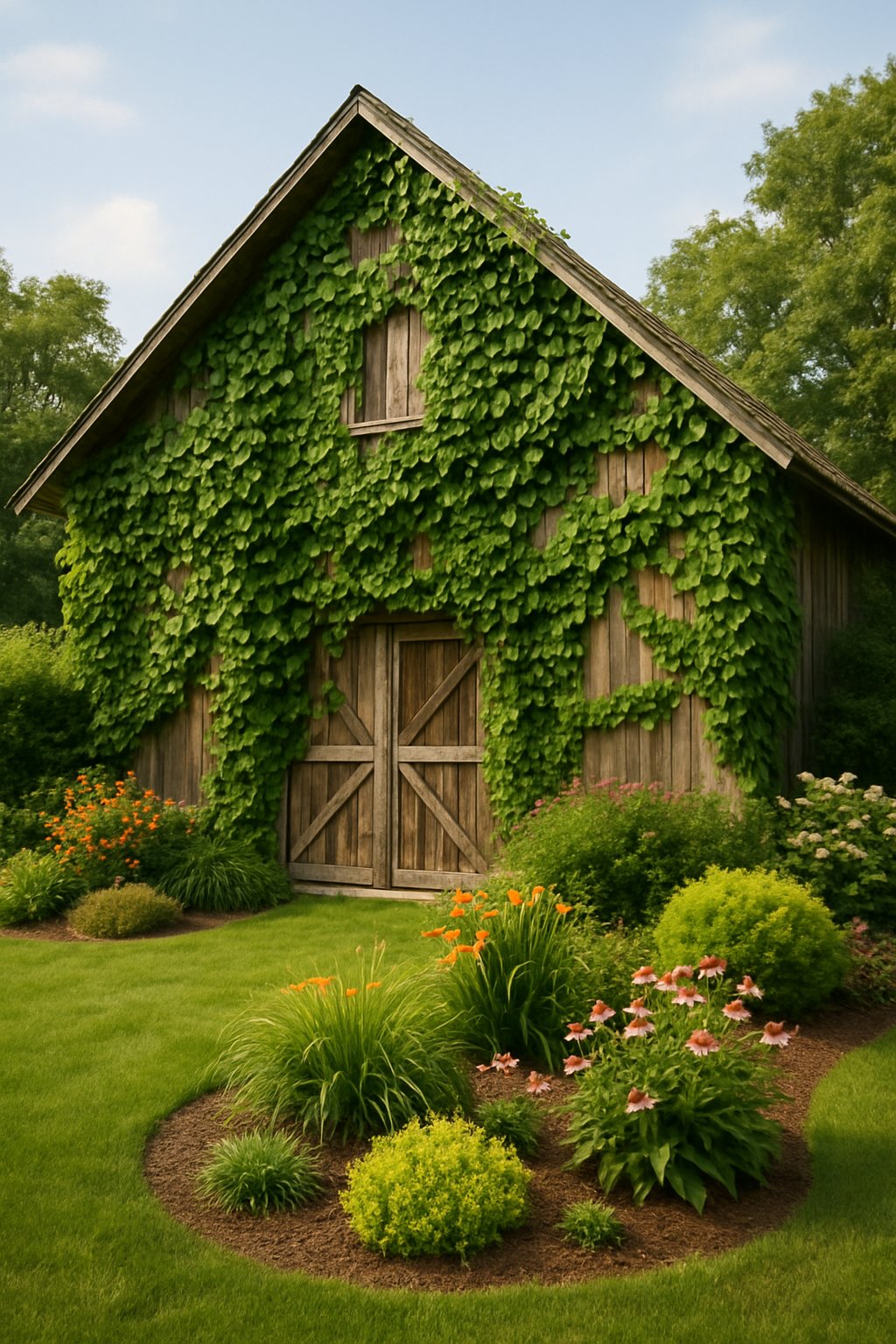
Climbing vines give your barn walls a natural, charming look. They soften the hard edges and add color and texture to big surfaces.
Vines like clematis, wisteria, or climbing roses work well on barns. You can train them to grow up trellises or attach wires to the walls for support.
This helps the plants spread evenly and protects the wood from damage. Start the vines near the ground in big pots or soil beds.
Flowering vines brighten the barn and provide shade during hot months. They also attract pollinators like bees and butterflies.
Check the growth regularly so vines don’t cover windows or doors. Water and prune your vines as needed to keep them healthy.
Pick species that suit your local climate for the best results.
Expert Tip from MrPlanter: “Choose fast-growing vines to cover your barn quickly, but prune them often to prevent overgrowth. Always plant near a water source for easy care.”
13. Install a cozy fire pit area
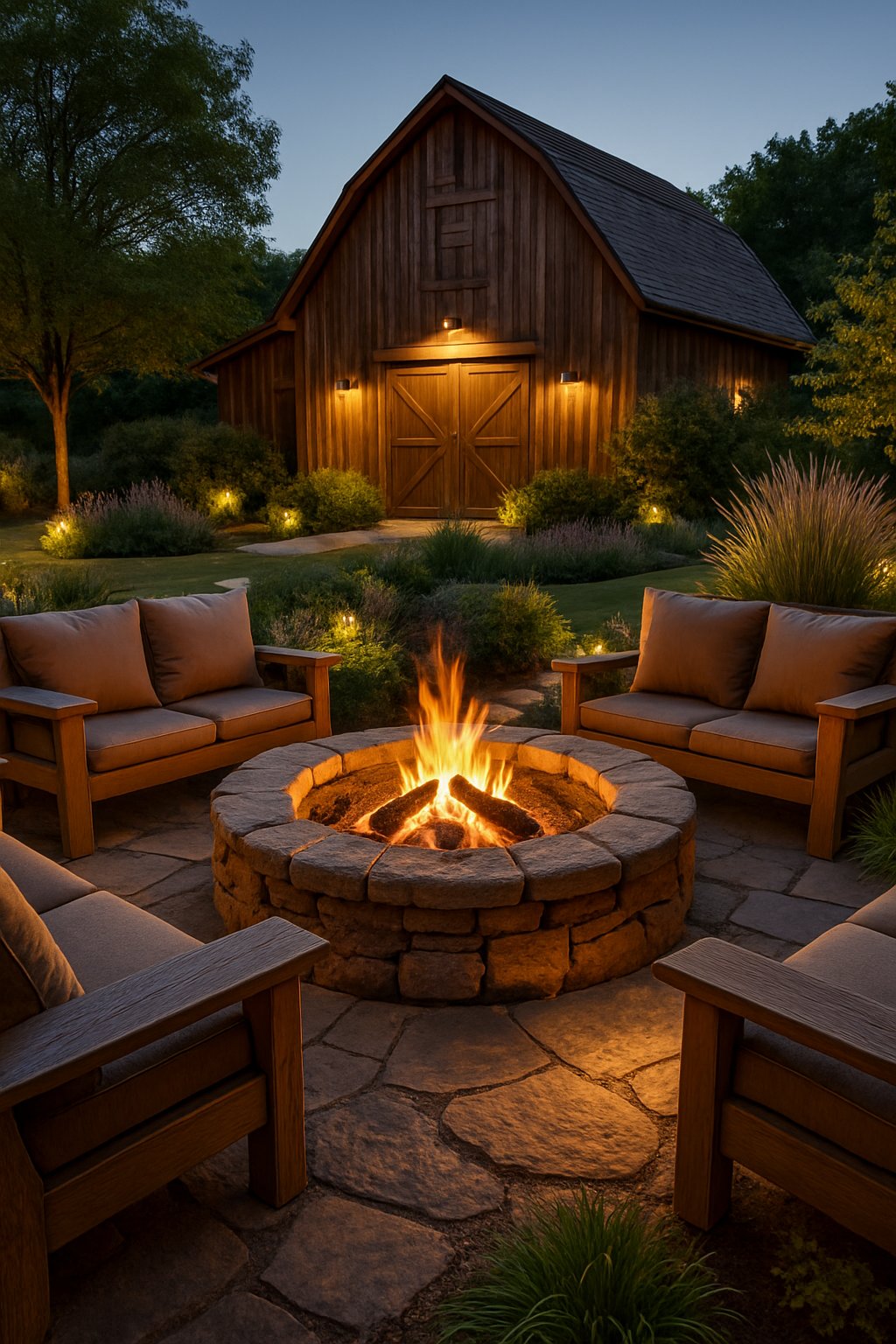
Put a fire pit near your barn to create a warm, inviting spot for gatherings. You can keep it simple or go for a more stylish look, depending on your space.
Stone or brick works great for durability and that rustic vibe. Place the fire pit at least 10 feet away from the barn and any trees to stay safe.
Add comfortable seating like benches or chairs to make it the perfect hangout. String lights or lanterns can boost the cozy feel.
Use gravel or pavers around the fire pit to keep things tidy and easy to maintain.
Expert Tip from MrPlanter: “Choose materials that blend with your barn’s style for a natural look. Always make safety your top priority by clearing flammable items nearby.”
14. Plant shade trees like oak and ash

Shade trees like oak and ash bring both beauty and function to your barn landscape. These trees grow strong and stick around for years.
They create cool, shaded spots that make working near your barn more comfortable. Oak trees are easy to care for and give a classic, natural look.
Ash trees grow fast and offer good coverage. Both types attract birds and wildlife, which adds life to your property.
Plant your shade trees a few feet from the barn to protect the foundation from roots. Make sure the soil drains well and water young trees regularly.
Over time, you’ll have a peaceful, shady place to enjoy.
Expert Tip from MrPlanter: “Choose native species like oak to support local wildlife. Plant trees early in the season for the best root growth.”
15. Add a vegetable and herb garden
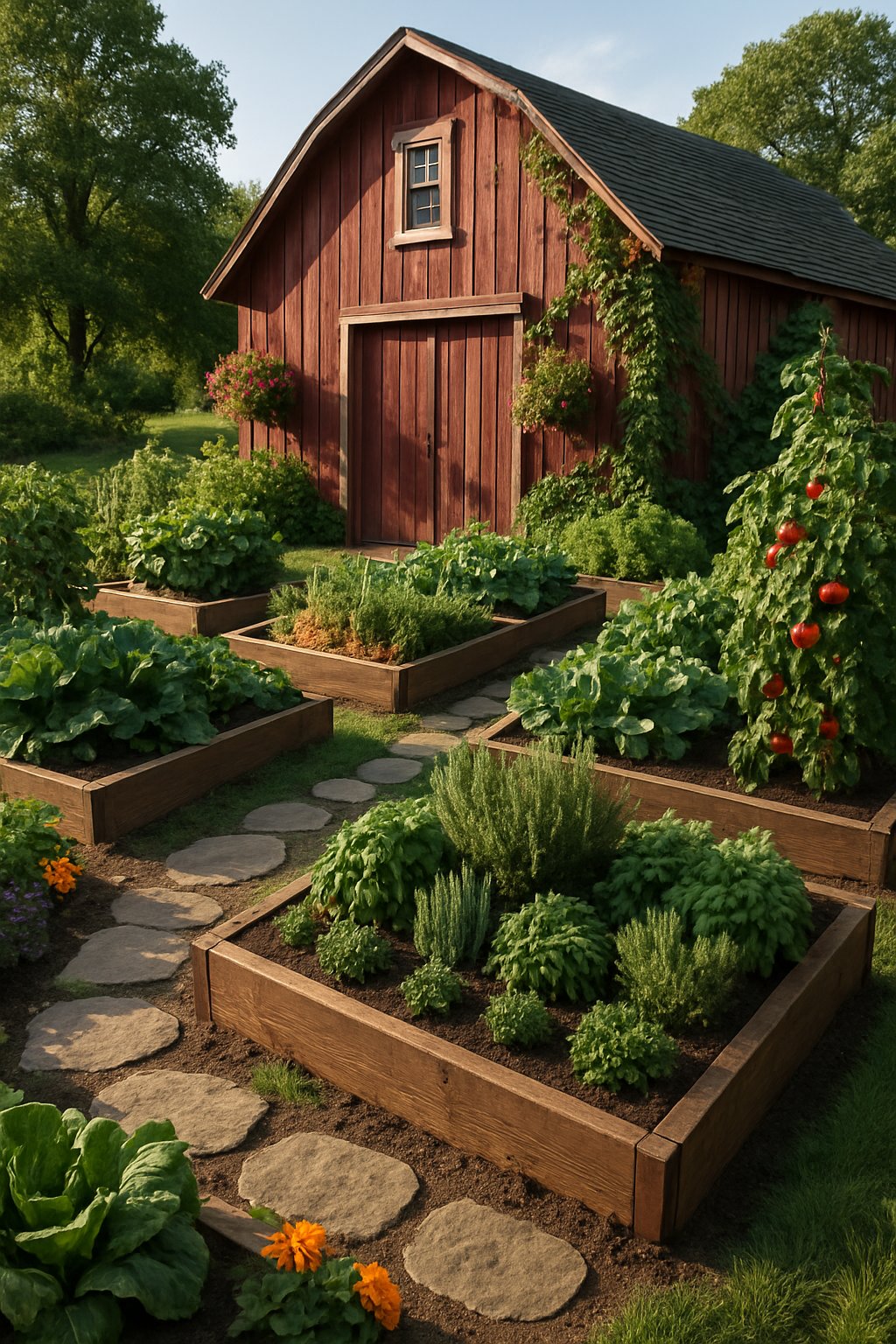
A vegetable and herb garden near your barn is a smart use of space. It brings fresh food close to home and adds color and life to your yard.
You can grow simple plants like tomatoes, basil, or lettuce without much trouble. Pick a sunny spot for your garden since most vegetables and herbs need at least six hours of sunlight daily.
Raised beds or containers work well if your soil isn’t great. They also help keep weeds under control.
Plant herbs like rosemary, thyme, and parsley next to vegetables. They improve your cooking and act as natural pest repellents.
You’ll love grabbing fresh leaves whenever you want. Rustic wooden planters or old crates add charm and keep your garden organized.
A small path with stones makes the garden more inviting and easier to walk around. You don’t need a huge garden— even a small plot can give you plenty of veggies and herbs.
Tending the garden near your barn can become a relaxing daily habit.
Expert Tip from MrPlanter: “Start with easy-to-grow veggies like radishes and spinach. They give quick results and build your confidence.”
16. Create an intimate seating nook
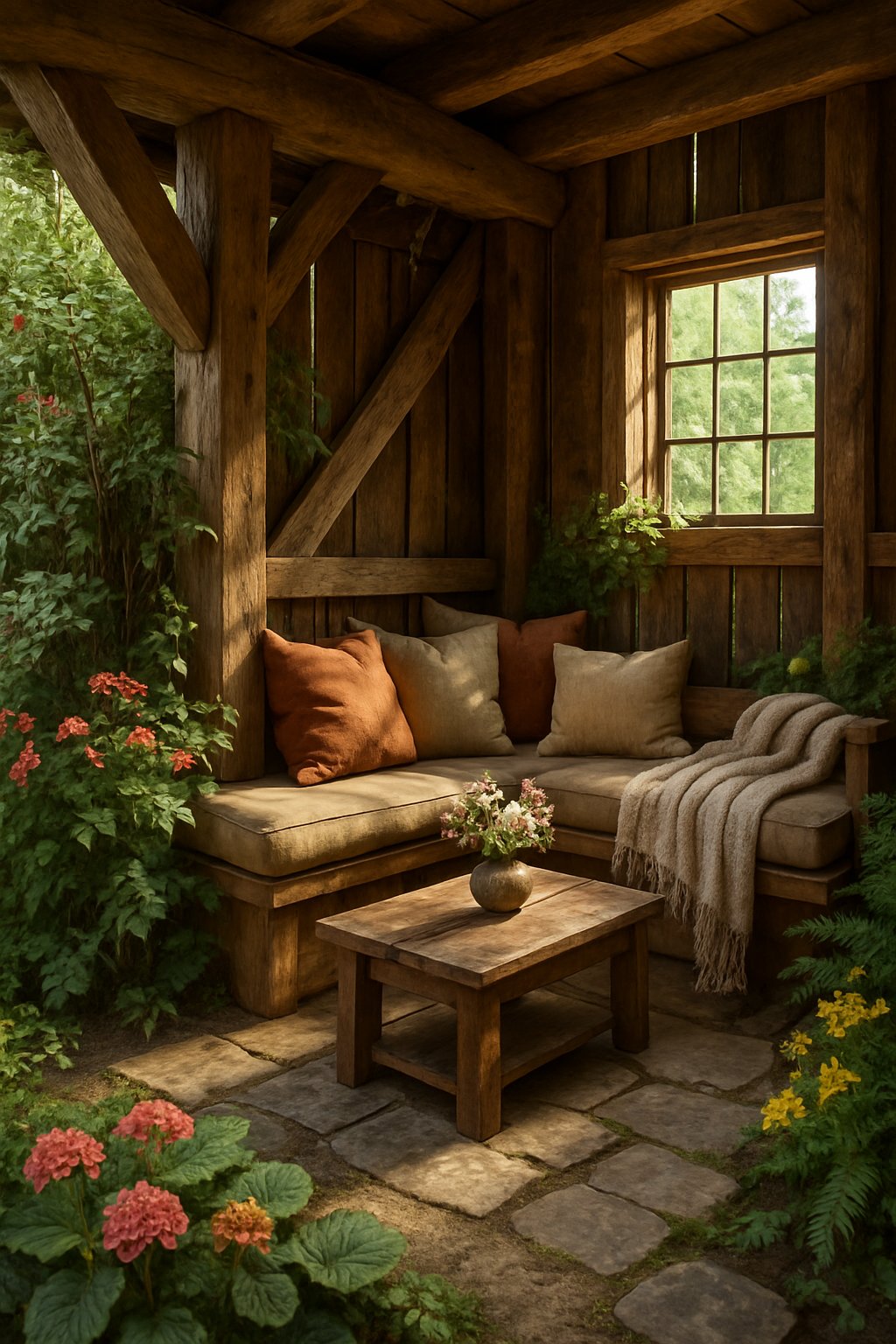
Turn a small corner of your barn yard into a cozy seating nook. Use natural elements like tall plants or trees to screen the area and give you privacy.
A simple bench or a few comfortable chairs makes the space feel inviting. Surround your nook with stone walls or wooden fences for a sense of enclosure.
Soft cushions and warm lighting help the space feel peaceful. This spot is perfect for reading, relaxing, or enjoying quiet moments outdoors.
Place your seating where sunlight filters through leaves but still offers shade. You can add climbing plants to walls or trellises for extra charm and seclusion.
Expert Tip from MrPlanter: “Use a mix of evergreen and seasonal plants to keep your nook private year-round. Small solar lights make the space cozy without needing wires.”
17. Use durable container plants by posts
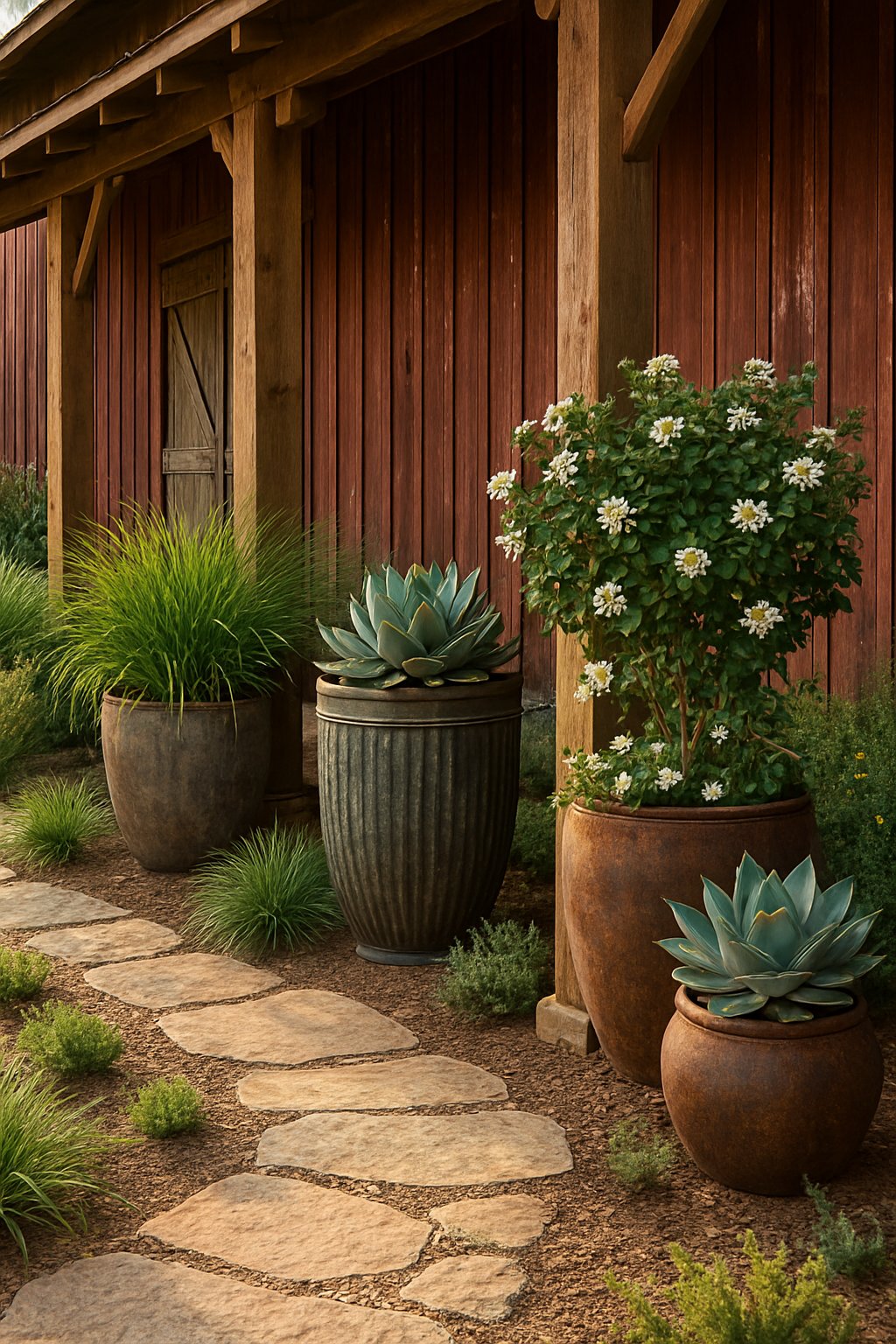
Place containers with tough plants near your barn posts to add color and interest without using much space. Pick plants that can handle wind, sun, and a bit of neglect—succulents or evergreens work well.
Containers protect plants from ground pests and make it easy to change your layout each season. Use simple pots made of terracotta or durable plastic for a stylish, low-hassle look.
Try grouping plants with different heights and textures for extra depth. This keeps the area around your barn lively.
Plants like mums or pansies add great fall and winter color when other plants go dormant. Water your containers carefully since they dry out faster than ground plants.
Adding mulch on top helps keep moisture in and cuts down on watering.
Expert Tip from MrPlanter: “Pick plants that need little water and can stand your local weather. Use pots with drainage holes to stop roots from rotting.”
18. Place decorative hay bales strategically

Use hay bales to create focal points around your barn. Put them near entrances, walkways, or seating areas to draw attention and add a rustic touch.
Stack them or arrange them in rows for different effects. Combine hay bales with seasonal decorations like pumpkins, corn stalks, or flowers.
This makes your barn feel welcoming and ties your landscape together. Cover hay bales with fabric or blankets to create seating spots for outdoor gatherings.
Decorative hay bales work for creating barriers or borders too. Place them along driveway edges or garden beds to define spaces without using anything permanent.
You can move them as needed for different events or seasons.
Expert Tip from MrPlanter: “Choose sturdy hay bales that won’t break down quickly in the weather. Position bales with a clear purpose, like seating or decorating, to keep your barn area tidy and inviting.”
19. Build raised flower beds

Raised flower beds add height and structure to your barn landscaping. Use wood, stone, or metal to make simple boxes that keep soil contained and improve drainage.
This makes it easier to grow healthy flowers close to the barn. These beds help define spaces and look great along walls or near entryways.
Pick colorful flowers or easy-care plants to brighten things up. Raised beds also protect plants from pests and weeds.
Building them yourself lets you pick the size and shape. You can even combine them with pathways or seating for a more inviting feel.
They bring a neat, tidy look to barn surroundings and boost curb appeal.
Expert Tip from MrPlanter: “Use untreated wood to avoid chemicals in your flower beds. Elevate beds by at least 12 inches for better root growth and easier maintenance.”
20. Add a rustic bench swing

A rustic bench swing brings charm and comfort to your barn landscaping. Hang it from a sturdy tree branch or a wooden frame near your barn.
It’s a cozy spot to relax and enjoy your outdoor space. Pick simple wood designs with natural finishes to match the rustic feel of your barn.
Adding cushions or a throw makes your swing even more inviting. Decorate around it with potted flowers or small plants for extra appeal.
A bench swing offers both style and function. It invites friends and family to sit and slow down for a while.
It also adds a welcoming touch that fits perfectly with farmhouse and rustic themes.
Expert Tip from MrPlanter: “Use weather-resistant wood and finish with outdoor sealant to keep your swing sturdy. Add hanging flower pots on the sides for extra color and charm.”
21. Install large barn doors painted bright colors
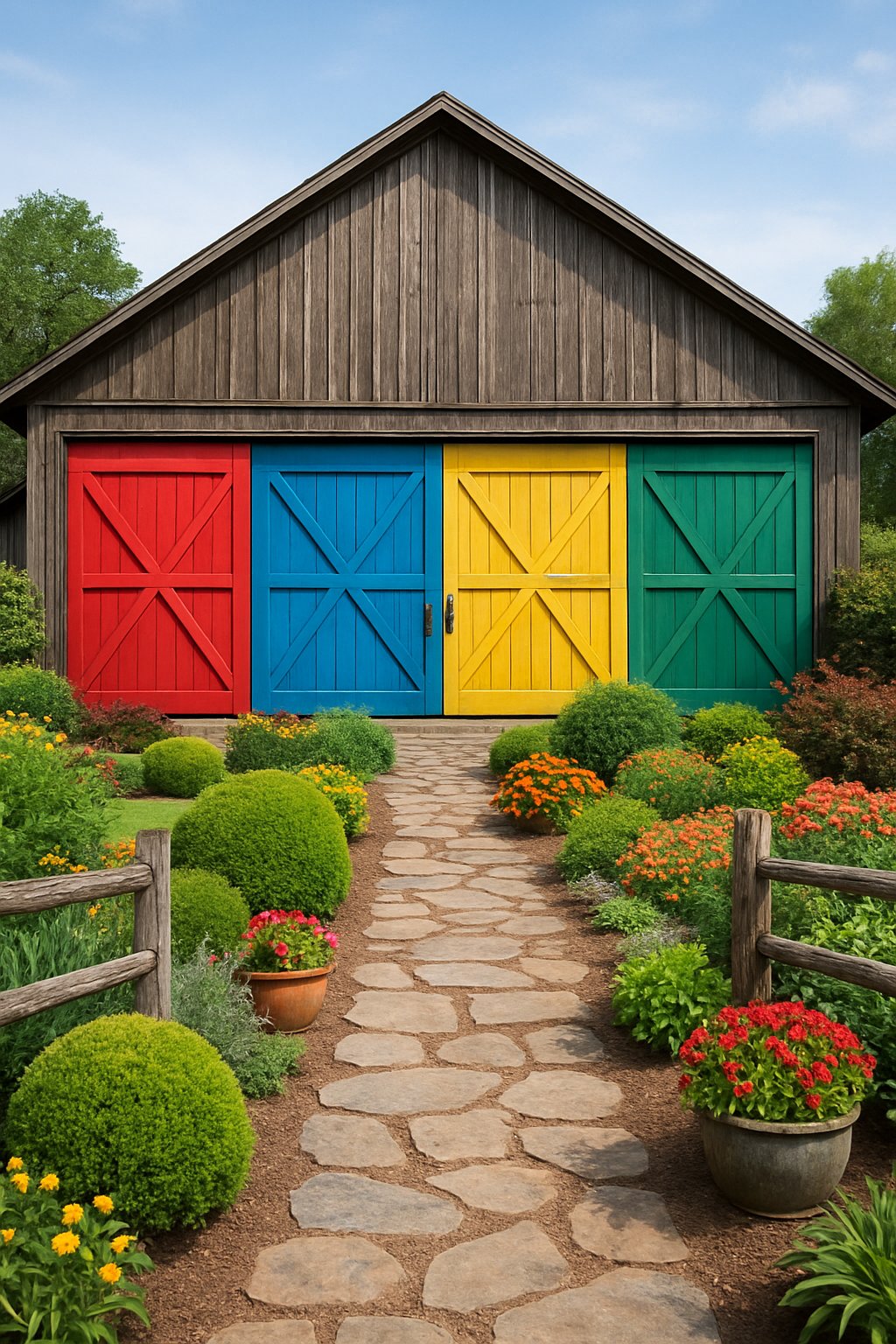
Go ahead and paint those big barn doors in bright colors. It’s a quick way to make your barn stand out and feel more lively.
Bright doors create a bold focal point that grabs attention in your yard. Try red, blue, or yellow if you want to add some energy and charm.
Pick colors that match or contrast with the rest of your barn’s surroundings. This pulls the whole design together and makes everything feel intentional.
Bright doors also make your barn easier to spot from down the road. That’s handy if you’ve got visitors or deliveries.
Use good-quality outdoor paint so the color lasts through the weather. Prep the doors first—clean and sand them—so the paint sticks and looks fresh.
Besides looking great, big barn doors give you easy access inside. Moving equipment, tools, or animals gets way simpler with wide doors.
And honestly, opening a cheerful, colorful door just feels good. It adds a friendly vibe to your whole barn area.
Expert Tip from MrPlanter: “Choose a color that complements your landscape to create harmony. Use weather-resistant paint to keep your barn doors looking great year-round.”
22. Use weathered metal art pieces
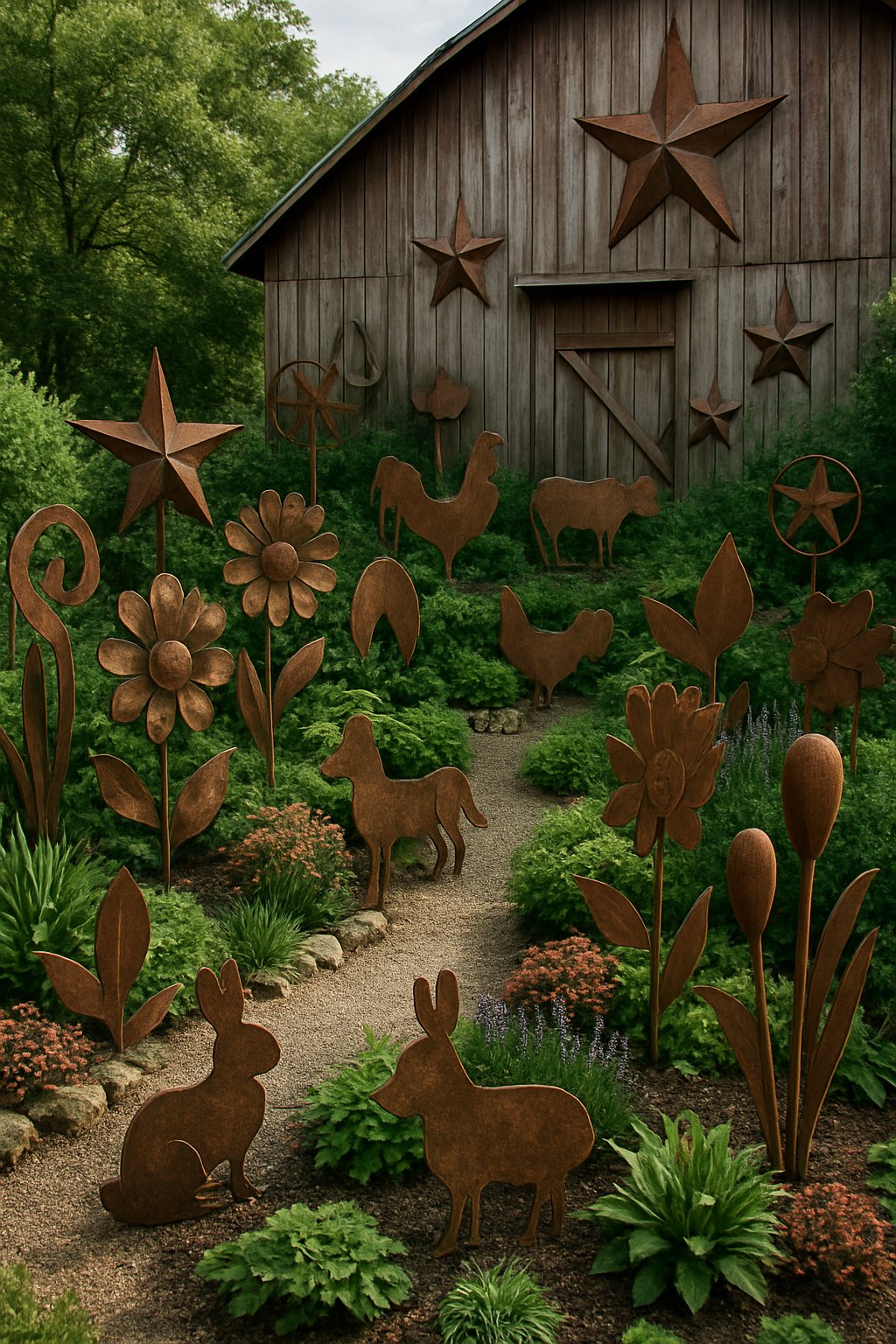
Weathered metal art brings rustic charm to any barn landscape. Rusty finishes and worn edges fit right in with an old barn’s vibe.
You can pick shapes like animals, vintage tools, or something abstract to keep things interesting. Place metal art near doors or along walkways so people notice them.
Old barn parts—think wheels or metal signs—make awesome wall decorations. You don’t really need fancy tools; nails or hooks usually do the trick.
Mix your metal art with plants to soften the look. Climbing vines or flowers growing around the pieces really make them pop.
That blend of natural growth and weathered metal just feels unique and eye-catching.
Expert Tip from MrPlanter: “Choose metal pieces with natural rust for an authentic look. Keep them in places where they won’t get damaged by weather or animals.”
23. Plant colorful annual flowers in pots
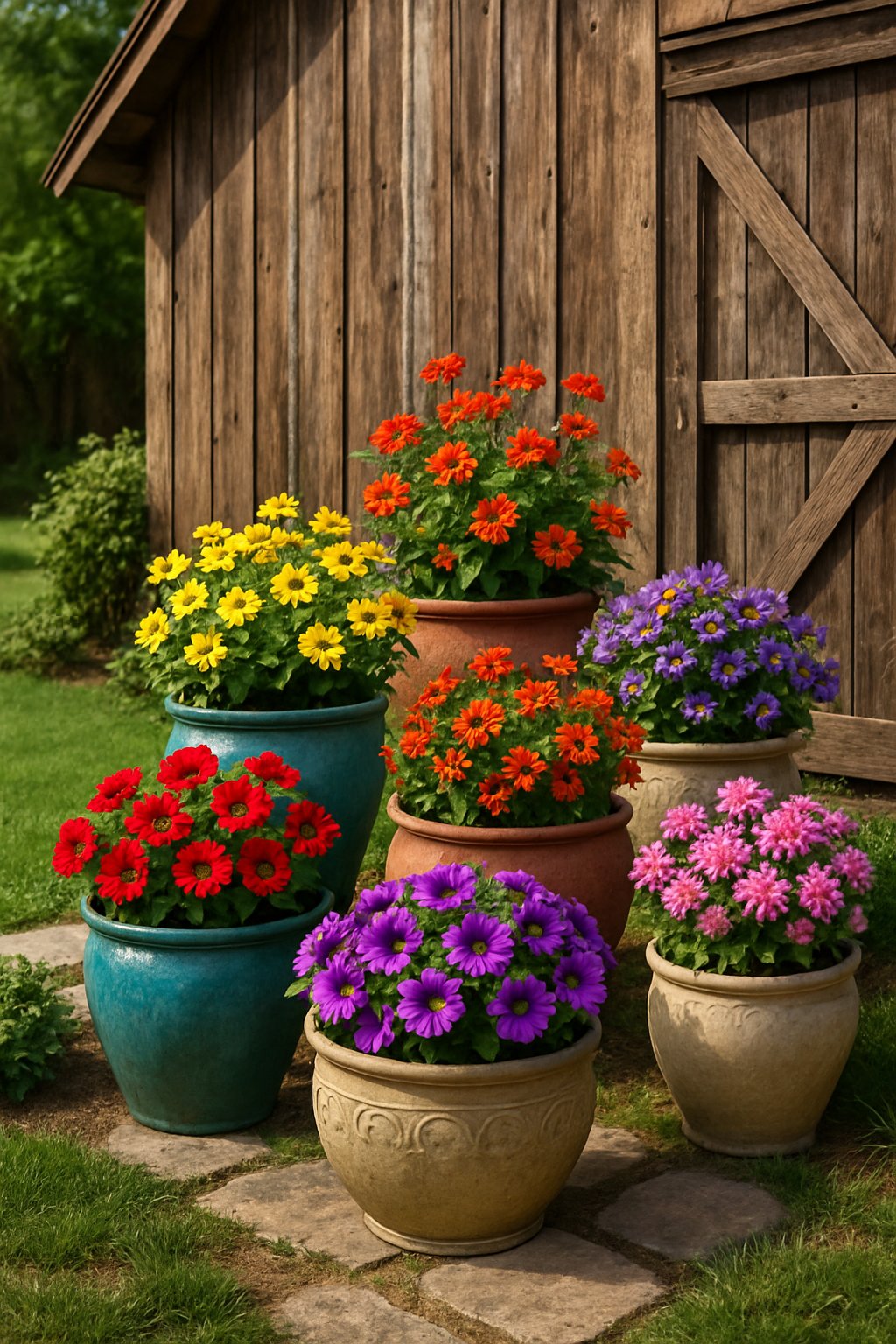
Put colorful annual flowers in pots near your barn and you’ll see the space brighten up fast. Try mixing pot sizes for variety—small pots with one color, big pots with taller plants and trailing blooms.
Pick annuals that suit your sunlight, whether you’ve got full sun or shade. Annuals bloom for months, so you get fresh color all season.
Group similar colors or types together for a tidy, bold look. Place pots by doors or along paths where folks will notice them.
You can swap out flowers every year to try new combos. It keeps the area around your barn feeling fresh and welcoming.
Expert Tip from MrPlanter: “Use good-quality potting mix and water regularly to keep annuals thriving. Rotate your pots each season to refresh your barn’s look without a lot of work.”
24. Create a compact fruit tree orchard
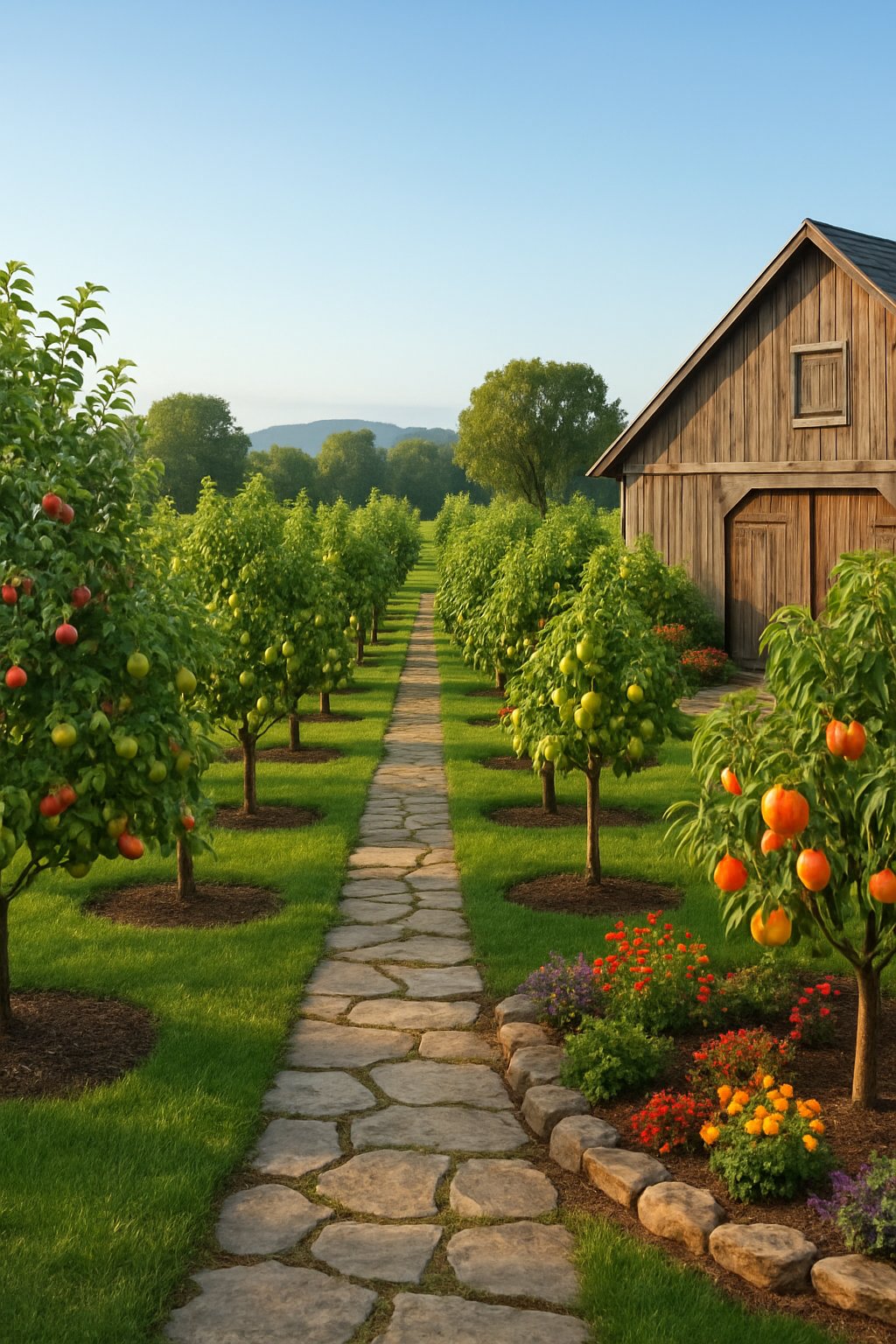
Even with limited space, you can grow a small fruit tree orchard. Pick dwarf or miniature fruit trees to keep things manageable.
These smaller trees still give you plenty of fruit without taking over your yard. Try espalier methods to train trees flat against a fence or wall.
That saves space and makes picking fruit a breeze. Plant some herbs like thyme or oregano under the trees—they help cut down on weeds and attract pollinators.
Prune your trees regularly to keep them healthy and compact. Summer pruning lets in sunlight and encourages fruit.
With a little planning, you’ll have fresh fruit right by your barn, no giant yard needed.
Expert Tip from MrPlanter: “Use summer pruning to control tree size and improve fruit quality. Planting herbs under your trees helps both growth and pollination.”
25. Lay down mulch for weed control
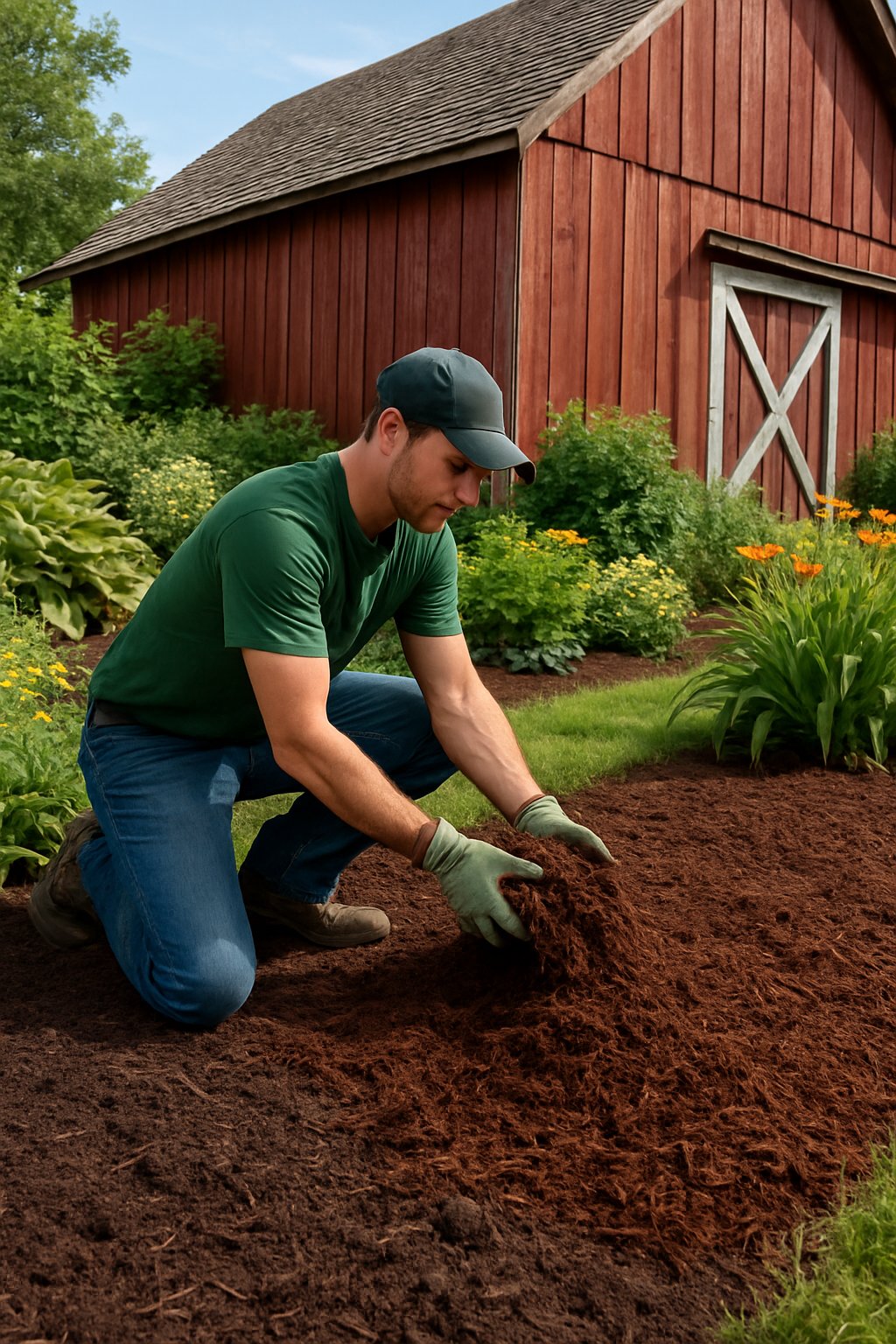
Mulch makes it way easier to keep weeds from popping up around your barn. Cover bare soil with a layer of mulch and you block sunlight, stopping weed seeds from sprouting.
That means less weeding for you. Before you start, clear out rocks, old mulch, and any debris.
You can add landscape fabric under the mulch for even better weed control. The fabric blocks weeds but still lets water and air get to your plants.
Spread 2 to 4 inches of mulch for a solid barrier. Organic mulch like wood chips or straw breaks down over time and adds nutrients to your soil.
You get a tidy, natural look that works well with barn landscaping. Mulch keeps the soil moist and the temperature steady, so your plants stay healthier.
It also makes your garden look finished and well-kept. Not a bad deal for a little effort.
Expert Tip from MrPlanter: “Spread mulch evenly and don’t pile it against plant stems to avoid rot. Use mulch to create clean edges around paths and flower beds for a polished look.”
26. Set up bird feeders and houses
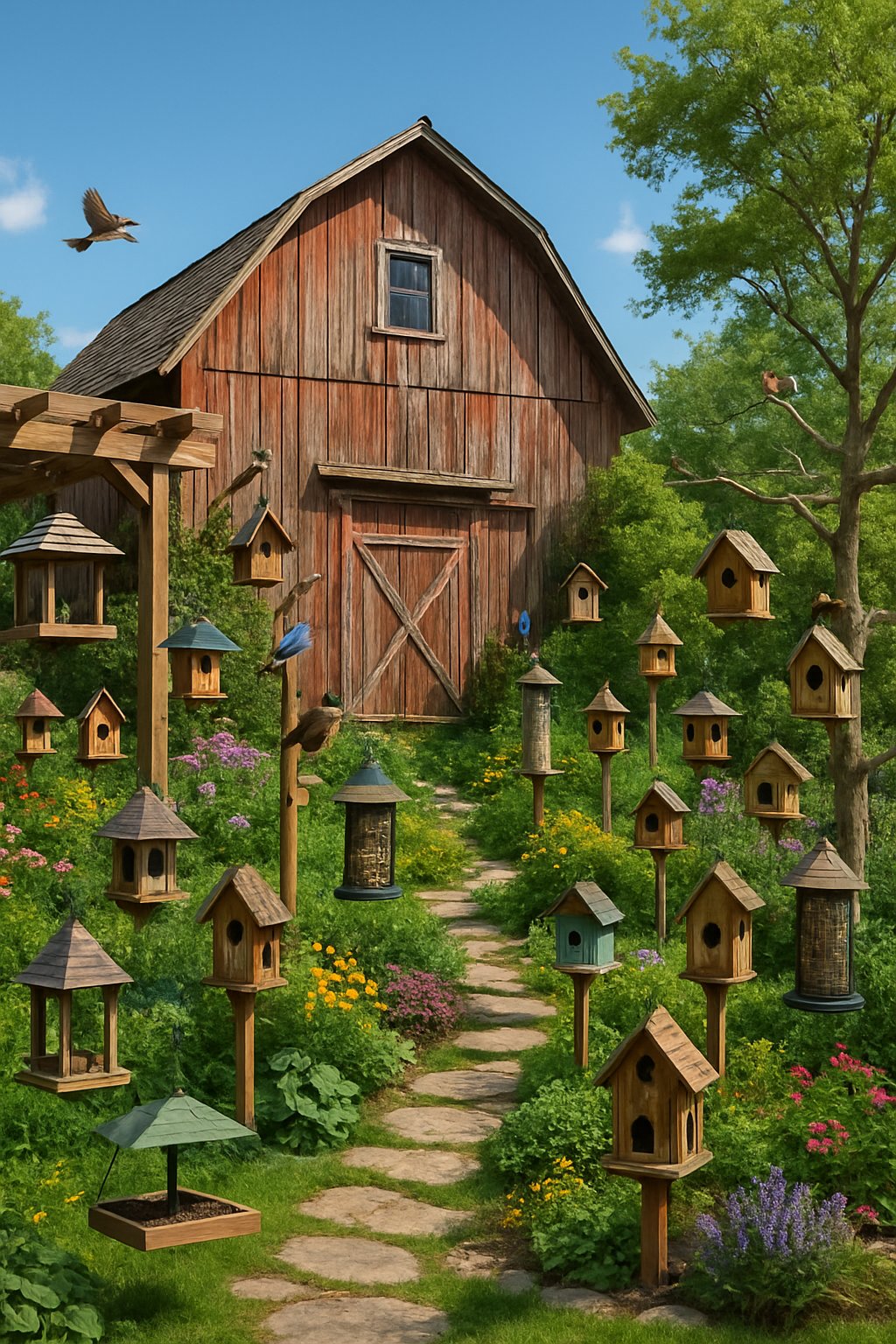
Put up bird feeders and houses near your barn, and you’ll notice more life and movement outside. Attract different birds by using feeders with a mix of seed types.
Set the feeders where you can watch them, but not so close that birds leave droppings on your barn walls. Birdhouses give birds a safe spot to nest.
Place them in shady, quiet areas away from predators. Surround the setup with plants or mulch for a more natural look and easier cleanup.
Try building a feeding station from recycled materials if you’re feeling crafty. It adds character and keeps everything organized.
Clean your feeders regularly to keep mold and pests away. It’s a small job that makes a big difference.
Expert Tip from MrPlanter: “Use mulch under feeders to catch seed shells and make cleaning simple. Change seed types seasonally to attract a wider variety of birds.”
27. Use gravel driveway edging for neatness
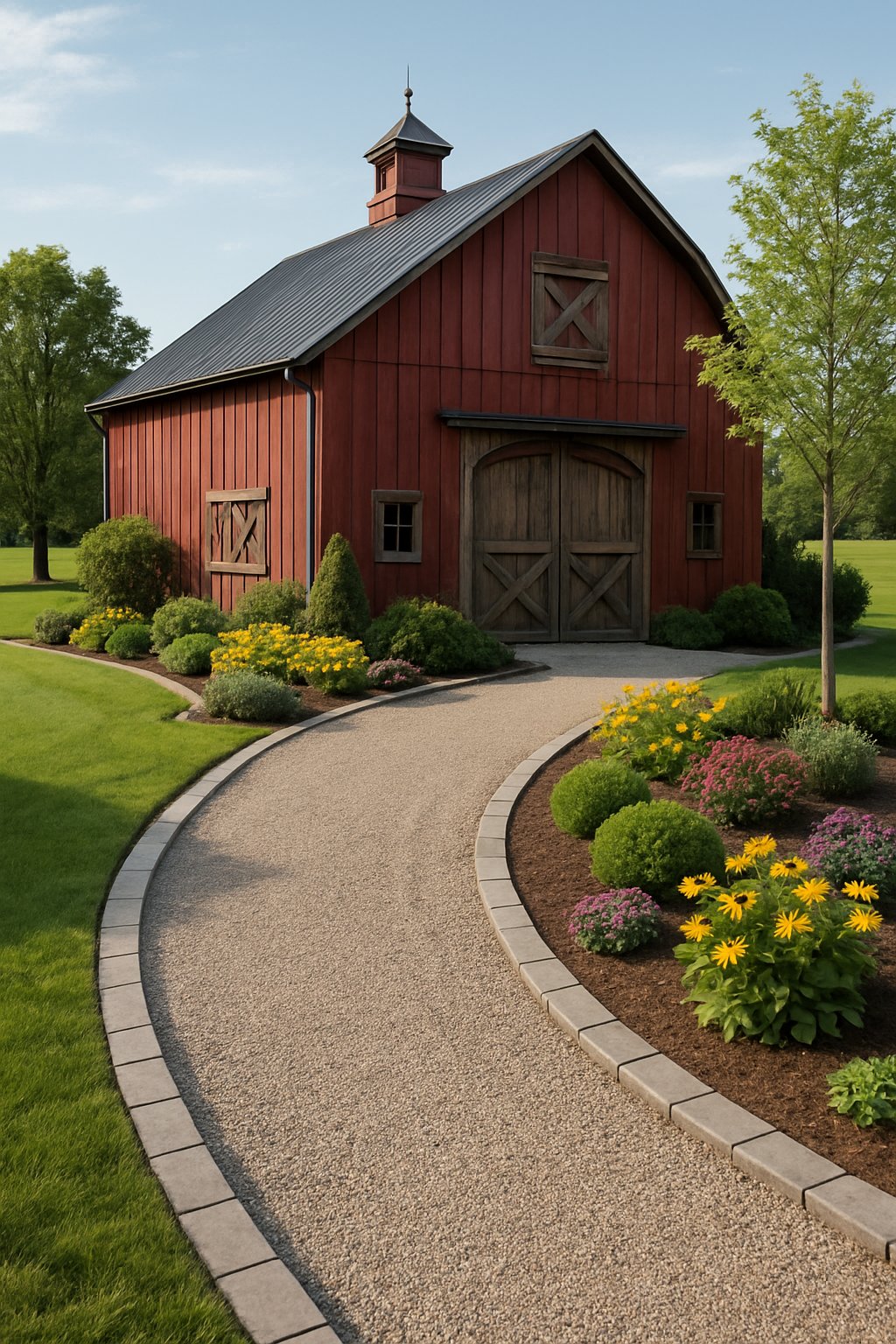
Gravel driveway edging keeps your driveway looking clean and organized. It also stops gravel from sneaking into flower beds or grass, which nobody wants.
You can pick materials like metal, plastic, rubber, or stone for edging. Each type holds the gravel where it belongs and adds a finished look.
Try using mulch or plants along the edge if you want a more natural vibe. Just remember to use a solid border so your plants and gravel don’t get mixed up.
Landscape timbers work as a simple, affordable choice. They bring a rustic touch and you can install them pretty easily along the driveway.
If you’re feeling creative, glass bottles or colorful stones can show off your style. These options make your barn space feel personal and still keep things neat.
Expert Tip from MrPlanter: “Pick edging that matches your barn’s style and climate. When you install it right, you’ll avoid gravel spreading and save yourself maintenance headaches.”

